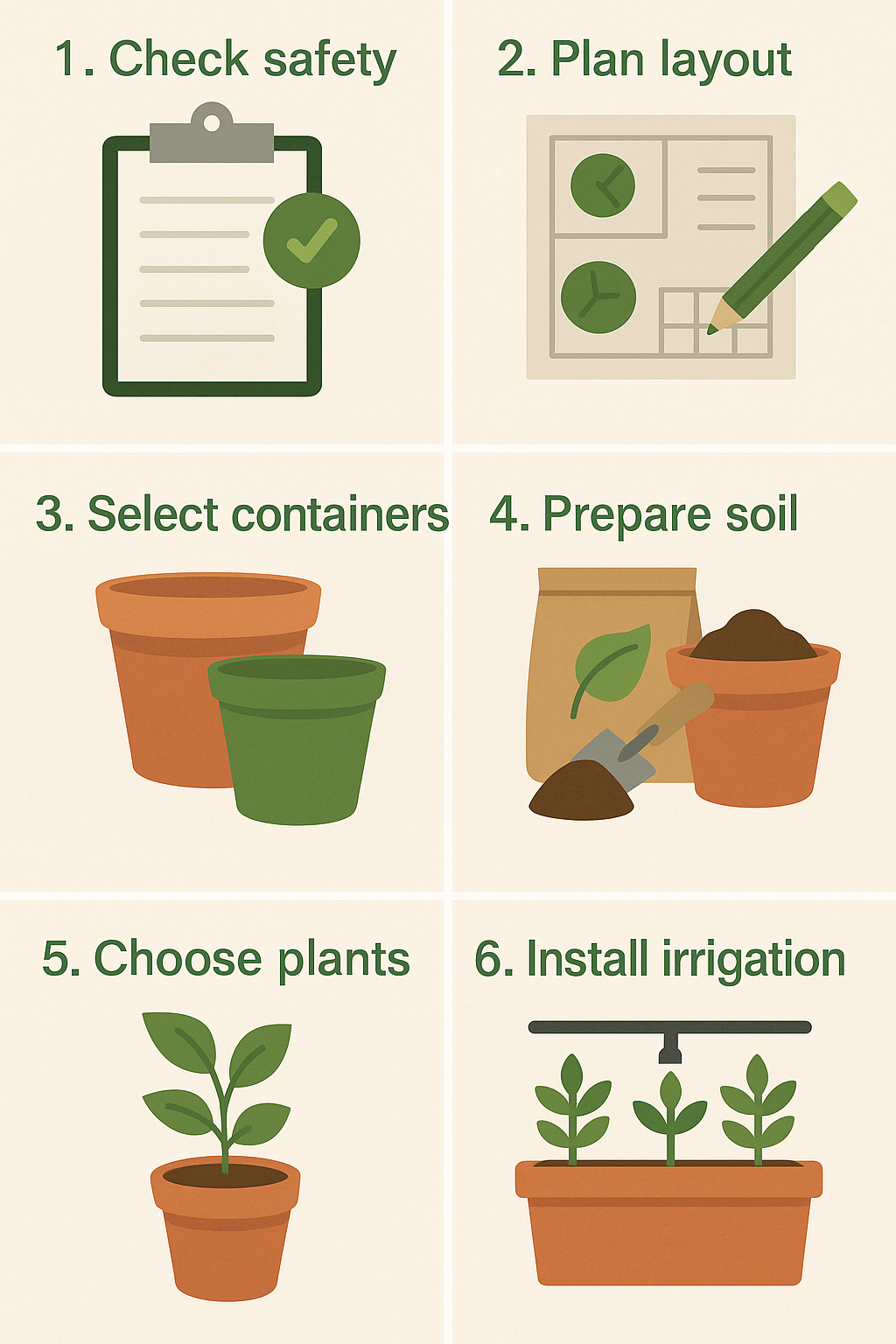Rooftop garden tips for city dwellers with limited space are becoming increasingly valuable as more people seek creative ways to enjoy greenery in urban environments. Living in a bustling city often means sacrificing access to traditional gardens, but with a rooftop, you can transform unused space into a vibrant and productive oasis.
This guide will walk you through practical ideas, plant choices, and maintenance strategies so you can start and sustain a thriving rooftop garden, even with minimal square footage.
Why Rooftop Gardens Are Perfect for Urban Living
Rooftop gardens offer unique benefits that go beyond aesthetics.
Advantages:
- Maximizes unused space: Turns rooftops into functional green areas.
- Improves air quality: Plants filter pollutants and produce oxygen.
- Reduces heat: Rooftop greenery lowers temperatures inside buildings.
- Enhances well-being: Gardening reduces stress and promotes relaxation.
Additionally, rooftop gardens can help reduce rainwater runoff and increase building insulation.
Step 1: Check Structural Safety and Permissions
Before you start planting, ensure your building can support the weight of a rooftop garden.
- Consult a structural engineer: Verify load-bearing capacity.
- Check local regulations: Some cities require permits for rooftop installations.
- Plan drainage: Prevent water accumulation that can damage the building.
💡 Tip: Lightweight soil mixes and raised beds made from lightweight materials help reduce total load.
Step 2: Plan Your Layout for Maximum Efficiency
A good design makes a big difference in limited spaces.
Layout Planning Tips:
- Zoning: Separate areas for seating, planting, and storage.
- Vertical gardening: Use trellises, wall planters, and shelves to save space.
- Container mobility: Place plants in wheeled pots for easy rearrangement.
- Wind barriers: Use lattice panels or tall plants to reduce wind stress.
By planning carefully, you’ll make your rooftop both practical and visually appealing.
Step 3: Choose the Right Containers and Soil
Containers:
- Opt for lightweight, durable materials like fiberglass or plastic.
- Ensure proper drainage holes to prevent root rot.
- Consider self-watering containers for reduced maintenance.
Soil:
- Use light potting mixes enriched with compost.
- Avoid heavy garden soil, which retains too much water and adds unnecessary weight.
Step 4: Select Plants That Thrive on Rooftops
Rooftops often have more sun and wind exposure, so plant selection matters.
Best Choices:
- Heat-tolerant vegetables: Tomatoes, peppers, eggplants.
- Herbs: Basil, rosemary, thyme, oregano.
- Flowers: Marigolds, geraniums, zinnias.
- Drought-resistant plants: Succulents, lavender.
- Small fruit plants: Strawberries, dwarf citrus.
Mixing edible and ornamental plants makes your garden both beautiful and functional.
Step 5: Manage Sunlight and Wind Exposure
- Sunlight: Most plants need 6–8 hours of sun daily. Consider shade cloths for delicate species.
- Wind: Rooftops can be windy, so install windbreaks like trellises, screens, or tall plants.
- Microclimates: Observe how sunlight and wind patterns shift during the day and adjust plant placement accordingly.
Step 6: Watering Strategies for Rooftop Gardens
Water management is crucial in rooftop gardening.
- Install drip irrigation: Saves water and delivers moisture directly to roots.
- Mulch: Apply organic mulch to retain soil moisture.
- Water in the morning: Reduces evaporation and prepares plants for the day’s heat.
Step 7: Seasonal Maintenance and Care
- Pruning: Keeps plants healthy and prevents overcrowding.
- Fertilizing: Use organic fertilizers every 4–6 weeks during the growing season.
- Pest control: Monitor regularly and use natural solutions like neem oil.
- Seasonal planting: Rotate crops and switch plants according to the season.
Creative Ideas to Maximize Rooftop Space
1. Vertical Garden Wall
Grow herbs and flowers in wall-mounted pockets.
2. Raised Bed Section
Install raised beds with lightweight frames for vegetables and flowers.
3. Portable Planter Carts
Use rolling carts to move plants according to sunlight and weather.
4. Pergola with Vines
Add shade and beauty by growing climbing plants over a pergola.
5. Mini Greenhouse
Protect delicate plants during colder months with a compact greenhouse.
Step-by-Step Rooftop Garden Setup
- Check safety: Consult an engineer and review local codes.
- Plan layout: Define zones and choose a design.
- Select containers: Lightweight, durable, and well-draining.
- Prepare soil: Use a light mix enriched with compost.
- Choose plants: Select varieties suited for rooftop conditions.
- Install irrigation: Opt for drip systems to save time.
- Maintain regularly: Prune, fertilize, and monitor for pests.

For tips on growing fresh herbs in small outdoor spaces, check out our complete guide here.
Conclusion
Creating a rooftop garden in the city is a rewarding way to make the most of your available space. With smart planning, the right plant choices, and consistent care, you can turn a bare rooftop into a green sanctuary that offers beauty, food, and relaxation.
🌱 Save this guide for your next planting weekend! And share it with a friend who’s dreaming of starting their own urban rooftop oasis.
FAQs
1. Do I need permission to build a rooftop garden?
In most cities, yes. Check with your building management and local government before starting.
2. Can rooftop gardens support large trees?
Generally, no. Large trees are too heavy for most rooftops unless specially engineered.
3. How do I deal with extreme rooftop heat?
Use shade cloths, heat-tolerant plants, and mulch to protect soil moisture.
Looking for lightweight planters and drip irrigation kits? You can find excellent options here on Amazon.
Written by Kate Smith | Plant Care Enthusiast & Urban Gardener
